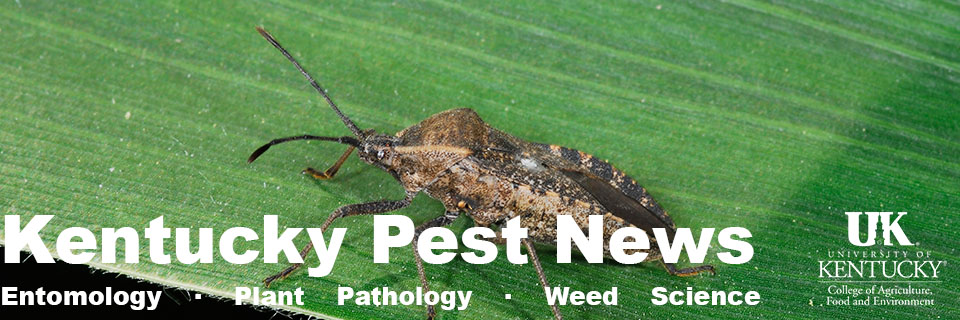The 2024 Southeastern U.S. Vegetable Crop Handbook is now available. This handbook represents a joint effort of vegetable production Extension specialists and researchers from 12 land-grant universities in the U.S., including the University of Kentucky. The latest information on cultivars,…
Blog Archives
IPM Scouting Guides for Common Problems of Vegetable Crops
Scouting and monitoring crops to determine potential problems before they result in serious economic loss is key to the Integrated Pest Management (IPM) approach. University of Kentucky Extension Specialists in Plant Pathology, Entomology, and Horticulture have collaborated to create IPM…
Commercial Spray Schedules for Field Production of Pumpkin, Squash & Zucchini (PPFS-VG-34 & PPFS-VG-35)
Pumpkin is the most common cucurbit crop grown commercially in Kentucky. Summer squash and zucchini are other popular cucurbits produced in open field production. These crops can be affected by various plant disease pathogens, resulting in crop damage and yield…
Commercial Spray Schedules for Production of Cucumbers (PPFS-VG-32 & PPFS-VG-33)
In Kentucky, cucumbers are common cucurbit crops produced in open fields and high tunnels. A number of plant pathogens can cause disease, resulting in crop damage and yield loss. Applications of fungicides and bactericides are often necessary to limit plant…
Yellow Vine Decline of Cucurbits (PPFS-VG-12)
Yellow vine decline (YVD) is uncommon during most production years in Kentucky; however, occasionally heavy losses may occur. This bacterial disease is vectored (carried from plant to plant) by squash bug. Susceptible cucurbits include squash, pumpkin, watermelon, and muskmelon (cantaloupe). …
Genetic Disorders that Resemble Foliar Diseases (PPFS-AG-C-15)
Genetic disorders of corn, often referred to as genetic flecking and lesion mimic, are non-infectious (abiotic) disorders that result in symptoms similar to many other foliar fungal or viral diseases of corn. This publication describes the symptoms associated with this…
Newly Released Vegetable & Hemp Videos
Dr. Nicole Gauthier, Plant Pathology Extension Specialist, has released two new videos related to vegetable and hemp diseases. Each title, along with a summary of the presentation, video run time, and Web link, are listed below: Southern Blight of Vegetable…
Purple Leaf Sheath of Corn (PPFS-AG-C-14)
Purple leaf sheath, also known as pollen rot or purple sheath blight, is a commonly occurring non-infectious (abiotic) disorder in Kentucky that affects the leaf sheath in corn. The symptoms of purple leaf sheath can be confused with other diseases,…
Botrytis Blight (in Spanish) (PPFS-GEN-19-S)
Rachel Rudolph, UK Horticulture Extension Vegetable Specialist, has spearheaded the translation of a number of Extension publications into Spanish, including plant pathology fact sheets. These publications are being translated by Natalia Martinez in Plant and Soil Sciences at UK. The…
Dothistroma Needle Blight of Pine (PPFS-OR-W-25)
Dothistroma needle blight is a fungal disease that most commonly affects Austrian pine (Pinus nigra) and Mugo pine (P. mugo) in commercial and residential landscapes. Damage results in brown needles and unsightly trees. In Kentucky, infections are thought to begin…
IPM Scouting Guides for Common Problems of Fruit Crops
One of the key components of IPM is to frequently scout and monitor crops to identify problems before they result in significant economic losses. Proper identification of pathogens, insect pests, nutritional, and physiologic disorders, as well as herbicide drift, is…
Using Prediction Models to Manage Diseases in Fruit (PPFS-FR-T-07)
Numerous plant diseases impact fruit crops throughout Kentucky. Factors such as plant growth stage, as well as rainfall, temperature, and other weather conditions, can be used to determine risk for plant disease. Disease prediction models are important tools for assessing…
Postharvest Disease Losses in Fruit & Vegetable Crops (PPFS-GEN-24)
Fruits and vegetables are often soft, perishable, and particularly susceptible to postharvest disease losses. Postharvest diseases can begin with infections in the field, during harvest, or in storage. Under moist or high humidity storage conditions, the infections can develop into…
Damping-off of Vegetables & Herbaceous Ornamentals (PPFS-GEN-03)
Damping-off can occur on any herbaceous crop grown from seed, including vegetables, ornamentals, hemp, and field crops. Seeds, seedlings, and young plants may be affected, resulting in poor stands in residential gardens, cold frames, greenhouses, high tunnels, and commercial fields.…
Black Rot of Grape (PPFS-FR-S-16)
Black rot is the most serious and prevalent grape disease in Kentucky. While this disease can affect all young developing plant tissues above ground, fruit infections are the most destructive. Without an adequate disease management program, both home and commercial…
